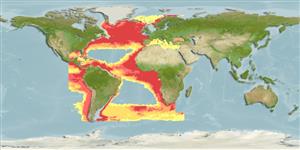Actinopterygii (ray-finned fishes) >
Stomiiformes (Lightfishes and dragonfishes) >
Sternoptychidae (Marine hatchetfishes) > Maurolicinae
Etymology: Maurolicus: Greek,mauros, -os, -on = dark + Greek,lykos = wolf (Ref. 45335).
Environment / Climate / Range
Ecology
Marine; bathypelagic; depth range 271 - 1524 m (Ref. 5204), usually 300 - 400 m (Ref. 82363). Deep-water, preferred 22°C (Ref. 107945); 72°N - 55°S, 180°W - 180°E
Sub-Arctic, and sub-Antarctic waters of the Pacific and Atlantic oceans and the Mediterranean Sea. Eastern Atlantic:: from Iceland and Norway to Senegal and from Democratic Republic of the Congo to Namibia. In tropical and subtropical waters.
Size / Weight / Age
Maturity: Lm ? range ? - ? cm
Max length : 8.0 cm TL male/unsexed; (Ref. 35388); common length : 4.0 cm TL male/unsexed; (Ref. 56527); max. reported age: 3 years (Ref. 56527)
Oceanic, found to depths of at least 1,524 m. Migrate in the water column at depths of 150-250 m during the day and to about 50 m at night (Ref. 57912, 107678). Mesopelagic (Ref. 5951); abundant near continental shelf-slope breaks and seamounts, rare in the open ocean (Ref. 107678). A cyclic selective feeder of copepods and euphausiids (Ref. 4739). They become sexually mature when 1 year old. Spawning takes place in March - September, producing 200-500 eggs, floating on the surface (Ref. 35388). Lipid content is 5.5 % in fresh body weight and wax ester is 15.3 % in total lipids (Ref. 8966).
Spawns at least twice in in a lifetime (Ref. 57912).
Wheeler, A., 1992. A list of the common and scientific names of fishes of the British Isles. J. Fish Biol. 41(suppl.A):1-37. (Ref. 5204)
IUCN Red List Status (Ref. 115185)
CITES (Ref. 94142)
Not Evaluated
Threat to humans
Harmless
Human uses
Fisheries: minor commercial
Tools
Special reports
Download XML
Internet sources
Estimates of some properties based on models
Phylogenetic diversity index (Ref.
82805): PD
50 = 0.5000 [Uniqueness, from 0.5 = low to 2.0 = high].
Trophic Level (Ref.
69278): 3.0 ±0.0 se; Based on diet studies.
Resilience (Ref.
69278): Medium, minimum population doubling time 1.4 - 4.4 years (K=0.88; Fec=200-500; tm=1).
Prior r = 0.61, 2 SD range = 0.2 - 1.81, log(r) = -0.49, SD log(r) = 0.55, Based on: 2 K, 1 tgen, 1 tmax, 3 Fec records
Vulnerability (Ref.
59153): Low vulnerability (13 of 100) .
